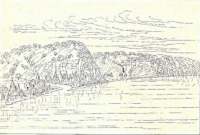Encyclopedia Dubuque
"Encyclopedia Dubuque is the online authority for all things Dubuque, written by the people who know the city best.”
Marshall Cohen—researcher and producer, CNN
Affiliated with the Local History Network of the State Historical Society of Iowa, and the Iowa Museum Association.
CATLIN, George: Difference between revisions
No edit summary |
No edit summary |
||
| Line 1: | Line 1: | ||
[[Image:GeorgeCatlin.gif|left|thumb| | [[Image:GeorgeCatlin.gif|left|thumb|200px|George Catlin]]CATLIN, George. (Wilkes-Barre, PA, July 26,1796--Jersey City, NJ, Dec. 23, 1872). Painter, ethnologist, writer. Catlin visited the Upper [[MISSISSIPPI RIVER]] in 1835. He spent many years studying Native American customs and is credited with four hundred seventy full-length portraits of Native Americans in the National Museum at Washington, D.C. | ||
Catlin's famous ''Letters and Notes on the Manners, Customs, and Condition of the North American Indians'', published in 1841, led to his recommending a trip by steamer from St. Louis to the Falls of St. Anthony with stops along the way at Rock Island, Galena, Dubuque, and Prairie du Chien. This "Fashionable Tour" was considered the part of the Far West accessible to the fashionable ladies of the eastern United States. | Catlin's famous ''Letters and Notes on the Manners, Customs, and Condition of the North American Indians'', published in 1841, led to his recommending a trip by steamer from St. Louis to the Falls of St. Anthony with stops along the way at Rock Island, Galena, Dubuque, and Prairie du Chien. This "Fashionable Tour" was considered the part of the Far West accessible to the fashionable ladies of the eastern United States. | ||
Dubuque was remembered by Catlin for its romantic and scenic qualities. Viewing the spectacular bluffs, the huge deposits of [[LEAD]], and the wide expanse of the river led Catlin to write that Dubuque would someday be the "mint" of the nation. | [[Image:catlinsketch.png|right|thumb|200px|Catlin sketch of the Dubuque grave.]]Dubuque was remembered by Catlin for its romantic and scenic qualities. Viewing the spectacular bluffs, the huge deposits of [[LEAD]], and the wide expanse of the river led Catlin to write that Dubuque would someday be the "mint" of the nation. | ||
[[Category: Artist]] | [[Category: Artist]] | ||
Revision as of 03:46, 21 May 2010
CATLIN, George. (Wilkes-Barre, PA, July 26,1796--Jersey City, NJ, Dec. 23, 1872). Painter, ethnologist, writer. Catlin visited the Upper MISSISSIPPI RIVER in 1835. He spent many years studying Native American customs and is credited with four hundred seventy full-length portraits of Native Americans in the National Museum at Washington, D.C.
Catlin's famous Letters and Notes on the Manners, Customs, and Condition of the North American Indians, published in 1841, led to his recommending a trip by steamer from St. Louis to the Falls of St. Anthony with stops along the way at Rock Island, Galena, Dubuque, and Prairie du Chien. This "Fashionable Tour" was considered the part of the Far West accessible to the fashionable ladies of the eastern United States.
Dubuque was remembered by Catlin for its romantic and scenic qualities. Viewing the spectacular bluffs, the huge deposits of LEAD, and the wide expanse of the river led Catlin to write that Dubuque would someday be the "mint" of the nation.



